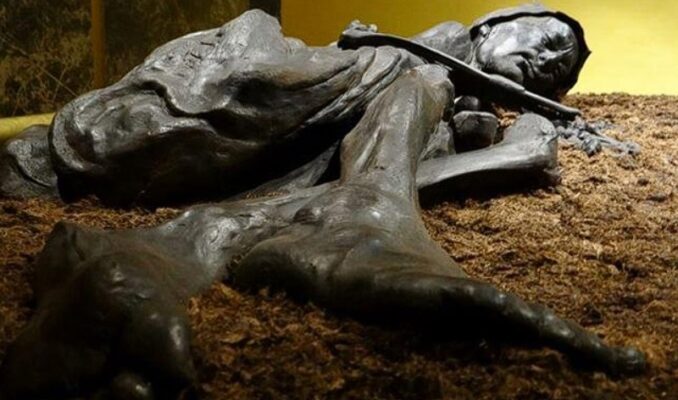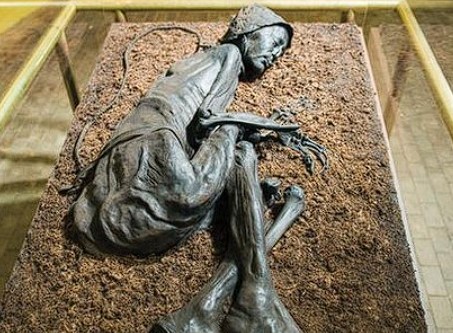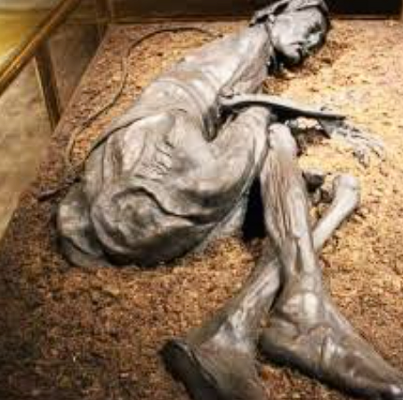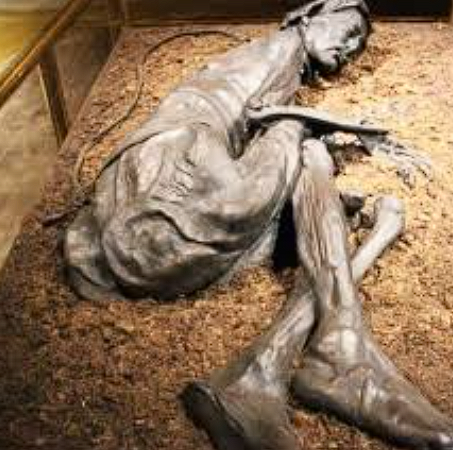The Tollund Man is one of the most astonishing archaeological discoveries of the 20th century. Unearthed in a peat bog in Bjældskovdal, Denmark, this naturally mummified body dates back over 2,400 years to the Iron Age. What makes his discovery so remarkable is the exceptional preservation of his body, which has allowed scientists to uncover fascinating details about his life, death, and the rituals of ancient societies.
Discovery of the Tollund Man
When and Where Was He Found?
The Tollund Man was discovered on May 6, 1950, by two brothers cutting peat near the town of Silkeborg, Denmark. Initially, they thought they had stumbled upon a recent murder victim because the body was so well-preserved. However, upon closer examination by archaeologists, it became clear that the remains dated back to the pre-Roman Iron Age, around 400 BCE.

The Condition of the Body
Unlike typical skeletonized remains, the Tollund Man’s skin, facial features, and internal organs were remarkably intact due to the unique conditions of the peat bog. The acidic, low-oxygen environment prevented bacterial growth, effectively preserving his body for centuries.
The Life and Death of the Tollund Man
What Do We Know About His Life?
Through scientific analysis, researchers have pieced together clues about the Tollund Man’s life. He was around 40 years old at the time of his death, stood about 5 feet 3 inches (161 cm) tall, and had a relatively lean build. His hands were smooth and free of calluses, suggesting that he may not have been a manual laborer, but rather someone of special status in his community.
Cause of Death: Human Sacrifice?
One of the most intriguing aspects of the Tollund Man is how he died. Unlike other bog bodies that show signs of violent deaths, the Tollund Man was found with a leather noose around his neck, leading experts to believe he was a victim of ritual sacrifice rather than an execution or murder. His peaceful facial expression indicates that he may have been sedated or willing to accept his fate.
Scientific Insights from the Tollund Man
What Was His Last Meal?
One of the most groundbreaking discoveries about the Tollund Man came from an analysis of his stomach contents. Scientists found that his last meal consisted of a porridge made from barley, flaxseeds, and other grains, indicating a simple but nutritious diet. This meal suggests he was part of an agricultural society that relied heavily on cereal crops.

Fingerprints and Facial Reconstruction
Amazingly, the Tollund Man’s fingerprints were still intact, allowing scientists to record them—something rarely possible with ancient remains. Additionally, modern forensic techniques and CT scans have enabled researchers to reconstruct his face, providing a realistic look at what he may have looked like over 2,000 years ago.
The Significance of the Tollund Man
What Does He Tell Us About Iron Age Rituals?
The Tollund Man’s remains provide significant insights into the religious and cultural practices of the Iron Age. The fact that he was carefully placed in the bog rather than hastily discarded suggests he was part of a ceremonial offering to the gods. This aligns with historical records and other archaeological finds indicating that human sacrifices were common in Northern Europe during this period.
Comparison to Other Bog Bodies
The Tollund Man is not the only bog body ever discovered, but he is certainly one of the best-preserved. Other well-known examples include the Grauballe Man and the Lindow Man, both of whom also appear to have been sacrificed. Studying these bodies together helps historians develop a clearer picture of Iron Age beliefs and customs.

Preservation and Display of the Tollund Man
How Was He Preserved After Discovery?
After the Tollund Man was excavated, experts faced the challenge of preserving his body outside the bog’s natural environment. While his head and face were successfully preserved, most of his body was allowed to deteriorate. Today, visitors to the Silkeborg Museum in Denmark can view his original head attached to a replica body, offering a chilling yet fascinating look at the past.
Public Interest and Ongoing Research
The Tollund Man continues to captivate the public and researchers alike. Advances in DNA analysis and forensic anthropology have allowed scientists to extract even more information from his remains. As technology improves, we may uncover further details about his origins, diet, and even his genetic lineage.
Conclusion: A Window into the Ancient World
The Tollund Man remains one of the most extraordinary archaeological finds in history. His exceptional preservation, mysterious death, and cultural significance provide us with a rare glimpse into life during the Iron Age. Whether seen as a sacrifice to the gods or a reflection of ancient traditions, his legacy endures as a testament to the rich and complex history of human civilization.
The next time you think about the past, remember the Tollund Man—a man who lived, died, and was preserved in time, offering us a direct connection to a world long gone but never forgotten.


CÁC TIN KHÁC
Mark Twain & Olivia Langdon: A 36-Year Love Story Filled with Laughter and Devotion
The Tollund Man: A 2,400-Year-Old Mystery Preserved in a Danish Bog
Skara Brae: Scotland’s Hidden Neolithic Village
Porta Nigra: The Hidden Depths of Trier’s Iconic Roman Gate